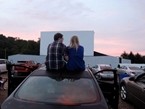By MITCH STACY
Associated Press
LANCASTER, Ohio
Through 80 summers, drive-in theaters have managed to remain a part of the American fabric, surviving technological advances and changing tastes that put thousands out of business. Now the industry says a good chunk of the 350 or so left could be forced to turn out the lights because they can’t afford to adapt to the digital age.
Movie studios are phasing out 35 mm film prints, and the switch to an eventually all-digital distribution system is pushing the outdoor theaters to make the expensive change to digital projectors.
The $70,000-plus investment required per screen is significant, especially for what is in most places a summertime business kept alive by mom-and-pop operators. Paying for the switch would suck up most owners’ profits for years to come.
The United Drive-In Theatre Owners Association figures 50 to 60 theaters have already converted. At least one operator decided to close instead of switch, but it’s not clear how many more might bite the dust.
Effinger worked at the Skyvue off and on for 30 years before he and his wife, Cathie, bought it two decades ago. They converted to digital last year, the first of the state’s 29 drive-ins to do so. Because the films now come on a device the size of a portable hard drive and are downloaded to his projector, it’s less hassle for him on movie nights and gives viewers a stunningly brighter, clearer image.
Think of the picture on a flat-screen digital TV, compared with the old tube set.
The digital transformation has been underway in the film industry for more than a decade because of the better picture and sound quality and the ease of delivery–no more huge reels of film. The time frame isn’t clear, but production companies are already phasing out traditional 35 mm film, and it’s expected to disappear completely over the next few years.
An industry incentive program will reimburse theater owners 80 percent of the cost of conversion over time, Vogel says, but because most drive-ins are small, family-run businesses, it’s hard for many to find the money, period. And the reimbursement doesn’t cover the tens of thousands of dollars more that many will have to spend renovating projection rooms to create the climate-controlled conditions needed for the high-tech equipment.
It’s a dilemma also faced by the nation’s small independent theaters, many of them struggling to pay for conversion to digital years after corporate-owned multiplexes already did it.
Darci and Bill Wemple, owners of two drive-ins in upstate New York, hope an online competition will help them with the $225,000 to $250,000 they figure it will cost to switch their three screens. The American Honda Motor Co. is compiling online votes for the nation’s favorite drive-ins and is going to pay the digital conversion costs for the top five vote-getters. The Wemples say that if they don’t get help, they’ll have to consider closing up.
The number of drive-ins peaked at more than 4,000 in the late 1950s. Now there are 357.
Robyn Deal and Dave Foraker have been going to the Skyvue in Lancaster since they were both in school in the 1960s and early ’70s. On a recent weekend night, they sat together in folding chairs outside their car, blankets on their laps and their 12-year-old dachshund, Wilson, getting lots of attention just before a double feature of “Turbo” and “The Wolverine.”
___
Associated Press writer Chris Carola in Albany, N.Y., contributed to this report.

COMMENTS
Please let us know if you're having issues with commenting.